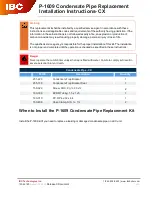
Benchmark 2.0 LN Installation, Operation & Maintenance Manual
CHAPTER 2 – INSTALLATION
OMM-0046_0J
AERCO International, Inc.
•
100 Oritani Dr.
•
Blauvelt, NY 10913
Page
27
of
168
GF-123
Ph.: 800-526-0288
06/18/2015
2.10.1 Outdoor Sensor In
(1)
An outdoor air temperature sensor (AERCO Part No. 122790) will be required primarily for the
Indoor/Outdoor reset mode of operation. It can also be used with another mode if it is desired to
use the outdoor sensor enable/disable feature. This feature allows the boiler to be enabled or
disabled based on the outdoor air temperature.
The factory default for the outdoor sensor is DISABLED. To enable the sensor and/or select an
enable/disable outdoor temperature, see the Configuration menu in Chapter 3.
The outdoor sensor may be wired up to 200 feet from the boiler. It is connected to the OUTDOOR
SENSOR IN and SENSOR COMMON terminals in the I/O Box (see Figures 2-9 and 2-10). Wire
the sensor using a twisted shielded pair wire from 18 to 22 AWG. There is no polarity to observe
when terminating these wires. The shield is to be connected only to the terminals labeled SHIELD
in the I/O Box. The sensor end of the shield must be left free and ungrounded.
When mounting the sensor, it must be located on the North side of the building where an average
outside air temperature is expected. The sensor must be shielded from direct sunlight as well as
impingement by the elements. If a shield is used, it must allow for free air circulation.
2.10.2 Air temp. Sensor
(2)
The Air Temperature Sensor is connected to the positive (+) and negative (-) terminals of the AIR
TEMP. SENSOR on the I/O board. This sensor measures the temperature of the air input to the
Air/Fuel Valve. This temperature reading is one of the components used to calculate the rotational
speed of the blower used in the combustion Calibration process (Chapter 4).
The AIR TEMP. SENSOR terminals can be used to add an additional temperature sensor for
monitoring purposes. This input is always enabled and is a view-only input that can be seen in the
Operating Menu. The sensor must be wired to the positive (+) and negative (-) terminals of the AIR
TEMP. SENSOR and must be similar to AERCO BALCO wire sensor Part No. 12449. A resistance
chart for this sensor is provided in Appendix C.
2.10.3 Analog In
(3)
The ANALOG IN + and – terminals are used when an external signal is used to drive the air/fuel
valve position (Direct Drive Mode) or change the setpoint (Remote Setpoint Mode) of the Boiler.
Either a 4 to 20 mA /1 to 5 VDC or a 0 to 20 mA / 0 to 5 VDC signal may be used to vary the
setpoint or valve position. The factory default setting is for 4 to 20 mA / 1 to 5 VDC, however this
may be changed to 0 to 20 mA / 0 to 5 VDC using the Configuration Menu described in Chapter 3.
If voltage rather than current is selected as the drive signal, a DIP switch must be set on the PMC
Board located inside the Control Box. Contact the AERCO factory for information on setting DIP
switches.
All of the supplied signals must be floating (ungrounded) signals. Connections between the signal
source and the Boiler’s I/O Box must be made using twisted shielded pair wire from 18 to 22 AWG,
such as Belden 9841 (see Figure 2-10). Polarity must be maintained. The shield must be
connected only at the source end and must be left floating (not connected) at the Boiler’s I/O Box.
Regardless of whether voltage or current is used for the drive signal, they are linearly mapped to a
40°F to 240°F setpoint or a 0% to 100% valve position. No scaling for these signals is provided.
















































